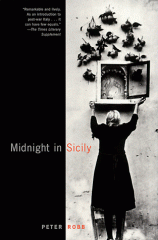Midnight in Sicily
Review
Midnight in Sicily
![]() What
What
do art, literature, history, travel, politics, food, and the Mafia
have in common? All are components of the rich and storied culture
of Italy and all come together in Peter Robb's marvelously
imaginative MIDNIGHT IN SICILY. Using the criminal trial of some of
Sicily's most notorious Mafiosi as his centerpoint, Robb
interweaves the various strands of his subjects into a seamless
tapestry that leaves the reader with a voyeuristic fascination,
combining fear of what one may find with a paralyzing inability to
look away.The
Mafia --- or Cosa Nostra --- faded during Mussolini's stranglehold
on the country during WWII. After the Allied invasion of Italy,
however, two Italian-born mobsters helped the Mafia regain power.
Lucky Luciano and Vito Genovese had garnered a certain infamy in
the '30s and '40s in the U. S. and their repatriation in 1946 would
change Italy forever.Little by little, the Cosa Nostra began to entrench themselves
into Italian society, pocketing both land and politicians via a
combination of bribes and the systematic elimination of any
obstacles. Disappearance and murder became an ever-increasing
phenomenon until the 1980s, when all-out war was declared. When
lifetime senator and seven-time prime minister Giulio Andreotti was
arrested for his Mafia connections, things reached a boiling point.
Several magistrates --- including the legendary Giovanni Falcone
--- along with numerous state officials and journalists were
blatantly murdered in retaliation for their attempts to bring the
Cosa Nostra to justice.Robb
documents the criminal intrigue with terrifying exactness, while
relaying the cultural and historical background needed to
understand the underpinning motivations and consequent
repercussions as the events unfold. While wandering the
labyrinthine alleyways of Palermo and pondering the dizzying maze
that is the Italian political machine, Robb happens on an outdoor
market that eerily mirrors the bloody reality of the
streets:"The
swordfish and tuna were flanked by many smaller fish, striped
mackerel and fat sardines, and squid and prawns and octopus and
cuttlefish... I remember how the diffused red light of the market
enhanced the translucent red of the big fishes' flesh and the
silver glitter of the smaller ones' skins. The meat was bright red
too, redder than usual in this hot muted light. The eye passed more
rapidly over the rows of kids' heads with melancholy deep black
eyes. There were coils of pearly intestines. There was horse flesh
and beef and pork and veal and skinny Mediterranean kids and lambs.
There were pale yellow chooks strung up by their bright yellow
feet, red crest downmost, and batteries of eggs."The
narrative of the trial and its various components is continually
interrupted by wonderfully esoteric tangents, from mouthwatering
descriptions of meals indulged in to an expose on the history of
the fork. The etymology of a particular word meanders to an
examination of the quality of coffee in various Italian cities, as
Robb comments that the coffee in Rome is often undrinkable, while
in Palermo the coffee is excellent. One journalist notes that for
Sicilians the ideal espresso "is a black drop containing a
superconcentration of all the caffeine in the world."Robb's examinations and opinions on Italian art and the
country's literary influences are a marvel, yet one is jolted back
into the heart of the Italian midnight by the continual
juxtaposition of poetic passages with distinctly matter-of-fact
prose: "The head decomposing on the front seat and the body found
when the car boot was cautiously opened had both belonged to a
Roman lawyer. He'd last been seen lunching at the Hotel Royal on
the seafront at Santa Lucia, looking out on the boat harbour with
its yachts and contraband fleet and the ancient castel dell'Ovo,
and beyond to the bay of Naples, Capri and Vesuvius. The lawyer had
been an unsavory type even in one piece."The
great Italian novelist Leonardo Sciascia called Sicily "a metaphor
for the modern world." It is a place where life is lived intensely,
for the shroud of death hangs ominously over everyone. Art and
literature hold a lofty place in the societal hierarchy, while food
and the appetites of the flesh form its heart. Braided like
arteries through the diverse body of this country are the darker
avenues of the human spirit represented by the Cosa Nostra. Peter
Robb uses masterful brushstrokes to paint a portrait that captures
the seductive beauty and the paradoxes of this intricately complex
island.
Reviewed by Vern Wiessner on January 22, 2011
Midnight in Sicily
- Publication Date: February 22, 1999
- Genres: Nonfiction
- Paperback: 400 pages
- Publisher: Vintage
- ISBN-10: 0375704582
- ISBN-13: 9780375704581



